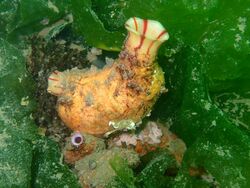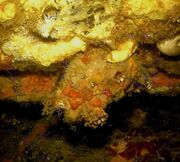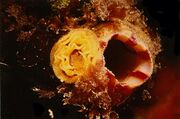Biology:Microcosmus sabatieri
| Microcosmus sabatieri | |
|---|---|

| |
| Microcosmus sabatieri | |
| Scientific classification | |
| Domain: | Eukaryota |
| Kingdom: | Animalia |
| Phylum: | Chordata |
| Subphylum: | Tunicata |
| Class: | Ascidiacea |
| Order: | Stolidobranchia |
| Family: | Pyuridae |
| Genus: | Microcosmus |
| Species: | M. sabatieri
|
| Binomial name | |
| Microcosmus sabatieri (Roule, 1885)
| |
| Synonyms[1] | |
| |
Microcosmus sabatieri, commonly called the grooved sea squirt,[2] sea fig,[3] or violet,[3] is a species of tunicates (sea squirts). The species has a rocky-shape appearance. It is mainly found in the Mediterranean Sea.[4] It is used as food in parts of Europe.[2]
Uses
Three species of Microcosmus are edible presently, M. sabatieri, M. vulgaris, and M. polymorphus (Vafidis 2008). [citation needed] In the Mediterranean Basin, it is eaten raw, often with an acidic condiment such as lemon juice or vinegar with shallots.[citation needed] It has a strong iodine taste which not all appreciate.[citation needed]
Names
The specific epithet sabatieri is in honor of zoologist Armand Sabatier.[3] The name 'violet' is from the distinguishing violet stripes on the siphon.[3]
The species has many common names. In Dutch it is violet-zakpijp (lit. violet pocket-pipe)[2] or begroeide zakpijp (overgrown pocket-pipe).[3] In French it's violet,[2][3] figue de mer (lit. sea fig),[3] and in Marseille, patate de mer (lit. sea potato),[3] or vioulé.[3] In Northern Catalonia it's called biju or bijut (jewel)[3] and in the Principality bunyol or ou de mar (sea fritter or sea egg).[5] In German the common term is Seefeige (lit. sea fig)[2] or eßbare Seescheide (edible sea sheath).[3] It is Φούσκα (Script error: The function "transl" does not exist., lit. bubble or puff) in Greek.[4] In Italian, limone di mare (sea lemon) or uova di mare (sea egg) are used.[3] Names in Spanish include provecho (profit), patatas de mar (sea potatoes), and buñuelo de mar (sea fritter).[3] In Ligurian it can be called stronsci de mä (sea turds).[3] In Morocco, in both Moroccan Darija and Berber, it's called Script error: The function "transl" does not exist. (فزضاض) or Script error: The function "transl" does not exist. (Script error: The function "transl" does not exist., أفزضاض).[6]
Other names it is sold under include:
- viourlet[citation needed]
- bijut/bichu[citation needed]
- carnummole (Campania)[citation needed]
- morsko jaje (lit. "sea egg"; Croatia)[citation needed]
- taratufi (Apulia)[citation needed]
Note that plants of the genus Carpobrotus are also known as 'sea figs'.[7]
Gallery
References
- ↑ Shenkar, N.; Gittenberger, A.; Lambert, G.; Rius, M.; Moreira Da Rocha, R.; Swalla, B.J.; Turon, X. (2018). Ascidiacea World Database. Microcosmus sabatieri Roule, 1885. Accessed through: World Register of Marine Species at: http://www.marinespecies.org/aphia.php?p=taxdetails&id=103844 on 2018-02-13
- ↑ 2.0 2.1 2.2 2.3 2.4 (in Dutch) Beleidsinformerende Nota: Wetenschappelijke en handelsbenamingen voor visserij- en aquacultuurproducten op de Belgische markt. Oostende: Vlaams Instituut voor de Zee. 12 October 2016. ISBN 978-94-92043-42-9. http://www.vliz.be/imisdocs/publications/ocrd/295899.pdf. Retrieved 13 February 2018. "Microcosmus sabatieri violet-zakpijp violet Seefeige grooved sea squirt"
- ↑ 3.00 3.01 3.02 3.03 3.04 3.05 3.06 3.07 3.08 3.09 3.10 3.11 3.12 3.13 Ader, Denis; André, Frédéric; Huet, Sylvie (7 August 2016). "Microcosmus sabatieri" (in French). http://doris.ffessm.fr/Especes/Microcosmus-sabatieri-Violet-817. Retrieved 13 February 2018.
- ↑ 4.0 4.1 Sanamyan, Karen; de Jong, Y. (5 December 2007). "Microcosmus sabatieri Roule, 1885" (in English). http://www.eu-nomen.eu/portal/taxon.php?GUID=urn:lsid:marinespecies.org:taxname:103844#expand. Retrieved 13 February 2018. "Vernaculars (-) Greek: Φούσκα"
- ↑ "Gran Diccionari de la llengua catalana". https://www.diccionari.cat/cerca/gran-diccionari-de-la-llengua-catalana?search_api_fulltext_cust=ou&search_api_fulltext_cust_1=&field_faceta_cerca_1=5065&show=title#.
- ↑ Mohamed Chafik (1999) (in Arabic). الدارجة المغربية، مجال توارد بين الأمازيغية و العربية. p. 51.
- ↑ "Sea figs Genus Carpobrotus" (in English). San Francisco. https://www.inaturalist.org/taxa/49323-Carpobrotus. Retrieved 13 February 2018.
External links
Wikidata ☰ Q3071662 entry
 |




